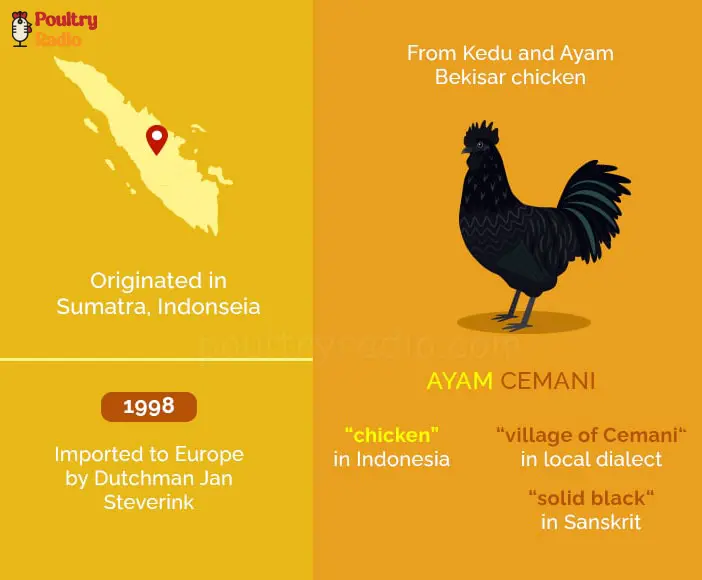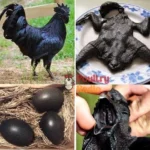Ayam Cemani Characteristics & Facts
Ayam Cemani is also called Black chicken. It is a completely black bird on the inside as well as the outside, it has naturally been related to the Dark Arts, particularly in its native Indonesia. Having all black feathers, a black comb, black skin, black meat, black internal organs, and even black bones make it unique.
We’ll look closely at these unique and fascinating black chickens in this article and help you decide if you should add them to your flock.
History and Background of the Ayam Cemani
In the 1920s, a Dutch colonist living in Java (Indonesia) made the initial discovery and documentation of the Ayam Cemani chicken breed. In 1998, they made their first appearances in Europe and the US and quickly jumped to fame.

The meaning of the name is a little confusing: “In Indonesian, Ayam means chicken, but Cemani can refer to either “solid black” in Sanskrit or it is the “village of Cemani” in Indonesia. It is up to you to decide.”
These birds serve as status symbols for wealthy people, who also take excellent care of them.
The blood and other parts of the bird are used in traditional medicine preparations, and they are considered lucky charms.
The Ayam Cemani is a magical being that helps connect the living with the realm of the spirit. It serves as a sacrifice bird for pleasing the Gods as a result. In Indonesia, people hardly ever consume its meat.
Appearance and Breed Standards of Ayam Cemani
The sight of Ayam Cemani’s is remarkable. In the sun, their all-black feathers have a stunning beetle-green shine. Some of the Ayam Cemani characteristics are given below:
| Weight | Male: 2.0–3.0 kg (4.5–6.5 lb) Female: 1.5–2.0 kg (3.5–4.4 lb) |
| Skin color | Black with a turquoise glow on the rooster neck side and tail. |
| Egg color | Tinted/cream/light blue |
| Comb type | Single |
These black chickens are not particularly large birds; the male weighs between 4.5 to 6.5 pounds, and the female weighs between 3.5 to 4.4 pounds.
Its shape is similar to that of its related species, the Jungle Fowl, with long tails, an elegant body, and long legs with sharp spurs.
The Ayam Cemani’s ultra-pigmentation throughout their tissues, caused by a fibromelanosis gene, explains their all-black exterior and interior colors.

The result is an abnormal build-up of melanin, the dark pigment found in the dermis and connective tissues of the skin. The gene responsible for fibromelanosis is autosomal dominant.
In addition to the Ayam Cemani, other breeds of chicken that carry this fibromelanosis gene include the Black H’Mong from Vietnam, Kadakhnath from India, and the Svart Höna from Sweden. This particular form of hyperpigmentation can also be seen in the well-known and popular Silkie breed.
Ayam Cemani chicks have very long legs and need to be completely black to be considered authentic.
Ayam Cemani Eggs (Laying ability and Broodiness)
The Ayam Cemani has a poor ability to lay eggs. They will lay about 80 eggs a year on average, or about one egg every week.
They certainly appear to go “off lay” for long periods. It seems that after laying 20–30 eggs, they will stop. After as long as six months, they’ll restart from the start!
The eggs of this black chicken are large compared to the hen’s size, and they are cream in color with a faint pink undertone.
The belief that Ayam Cemani hens lay black eggs is a popular one, but it is untrue.
Birds that do lay black eggs are the Red-legged or Blue Honeycreepers and Cayuga duck, which lay black eggs at the beginning of the season and gradually change them to white by the end.
The Ayam Cemani hen is not broody and typically does not settle well on her eggs. It’s best to hatch chicks in an incubator or under another breed of chicken, like an Orpington or Silkie, if you want them.
if you are looking for a chicken breed that lays maximum egg production then check this article: Top 10 Best Egg Laying Chickens
Temperament of the Ayam Cemani Breed
Overall, Cemani appears to be a friendly and charming bird. All of them, even the roosters, are wise, gentle, and docile. They are alert and active, still very much in the line of their jungle fowl ancestors. They take joy in having lots of room and going foraging. Due to their slight nervousness, they are generally not good lap chickens.

Ayam Cemani are generally peaceful and passive around other flock members, which makes them a good fit for households with other birds but non-aggressive breeds.
If provided with suitable housing and shelter, they can withstand the harsh winters in Vermont with ease.
It should go without saying that, given their Indonesian origins, they are also fairly heat tolerant.
Ayam Cemani’s Common Health Concerns
I was unable to find any specific health problem of this black chicken, but this is a good place to explain the fibromatosis.
The bird has a fibromelanistic gene mutation, which causes it to deposit an excessive amount of black pigment.
The skin and other tissues seem black due to this abnormal melanin accumulation.
Only three other birds—the Silkie, the Swedish Svart Hona, and the Madhya Pradesh-native Kadaknath chicken—have this genetic trait.
Although the blood is red, it is reportedly darker than usual but the bone marrow is black.
Is the Ayam Cemani (Black Chicken) the Ideal Choice for You?
You will need to save up some cash if you want to add a few of these stunning black chickens to your flock.
They charge $199.00 for an unsexed chick and $400.00 for a sexed juvenile, so these are not for the cheapskate or the weak of the heart!
Of course, you can find cheaper birds, but they’ll typically be of lower quality, so proceed with caution.
It’s not really a lap chicken; it’s described as friendly but not especially “cuddly.” They will eat from your hand.
They are unique and noteworthy, and many people purchase them as pets or eye candy.
Commonly Asked Questions
Why is Ayam Cemani black?
Ayam Cemani has a fibro melanistic gene mutation, which causes it to deposit an excessive amount of black pigment (melanin). The skin and other tissues seem black due to this abnormal melanin accumulation.
Are Ayam Cemani eggs black?

Ayam Cemani hens do not lay black eggs, despite popular belief to the contrary. The Ayam Cemani egg has a pinkish tinge and is cream in color.
Do black eggs exist?
Yes! Cayuga ducks, which lay black eggs at the start of the season that gradually turn white by the end, and Red-legged or Blue Honeycreepers are two examples of birds that lay black eggs.
Is Ayam Cemani and kadaknath same?

No, the distinctive feature of the Ayam Cemani and Kadaknath chicken breeds is their black meat. Whereas Ayam Cemani is from Indonesia, Kadaknath is from India.
When does Ayam Cemani start laying

The Ayam Cemani begins laying eggs between the ages of 5 and 6 months. Ayam Cemani chickens typically lay 50 to 80 eggs per year. Their behavior is cyclical and will often stop laying for several months between each cycle.
How much does an Ayam Cemani cost?
You will need to save up some cash if you want to add a few of these stunning black chickens to your flock. They charge $199.00 for an unsexed chick and $400.00 for a sexed juvenile, so these are not for the cheapskate or the weak of the heart!








